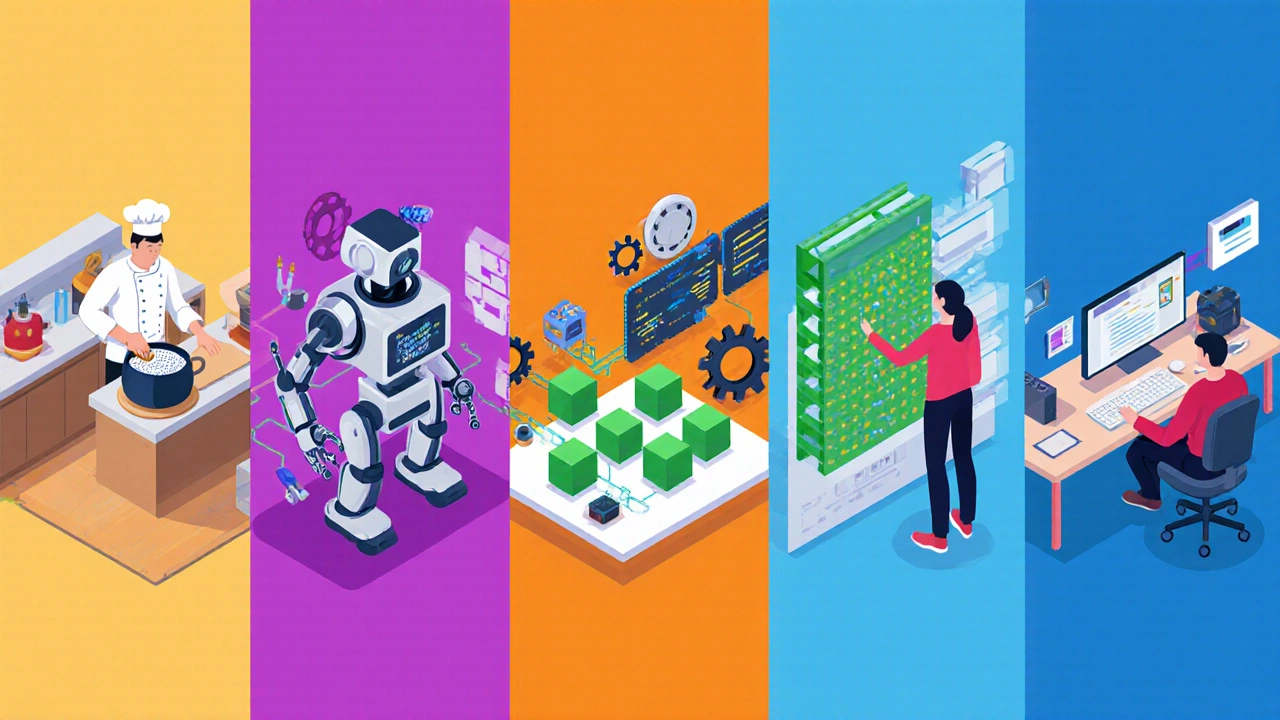
When you walk into a coding class, the first thing the instructor wants you to grasp is that not all code looks the same - there are distinct types of code that shape how you think about problems and build solutions.
Programming code types is a framework that groups source code by its structure, execution model, and typical use‑cases. Understanding these categories helps beginners choose the right tools, avoid common pitfalls, and progress faster through any curriculum.
Why Knowing the Different Types Matters
Every coding class builds on a foundation. If you treat all code as interchangeable, you’ll struggle when a new language or project demands a different approach. By the end of this guide you’ll be able to:
- Identify the five main code categories used in modern development.
- Match each category to real‑world scenarios you’ll encounter in class projects.
- Pick the right language and tools for a given assignment.
- Explain the pros and cons of each type to classmates or a teacher.
Quick Overview of the 5 Types
- Procedural programming
- Object‑oriented programming (OOP)
- Functional programming
- Declarative programming
- Scripting languages (often interpreted)
Deep Dive into Each Type
Procedural programming
Procedural code follows a top‑down flow: a sequence of steps, or procedures, manipulate data. Think of it as a recipe - the ingredients (variables) stay the same while the steps (functions) are executed in order.
Typical languages: C, Pascal, BASIC. In a coding class, procedural exercises often start with simple console apps that read input, compute, and print output. The strength lies in its simplicity, making it perfect for first‑year students learning control structures and basic algorithms.
Object‑oriented programming
OOP treats data and behavior as objects - self‑contained units that interact. Each object has properties (state) and methods (behaviour). This mirrors real‑world entities, allowing you to model complex systems like a library system or a video game.
Typical languages: Java, C++, Python (when used OOP‑style). In class projects, OOP shines when you build simulations, GUIs, or any system where you can define reusable components.
Functional programming
Functional code treats computation as the evaluation of mathematical functions, avoiding mutable state and side effects. Instead of changing variables, you create new values based on old ones.
Typical languages: Haskell, Scala, LISP, modern JavaScript (with map/filter/reduce). Functional style is great for parallel processing and data pipelines - topics that often appear in advanced data‑science modules.
Declarative programming
Declarative code describes *what* you want, not *how* to achieve it. SQL queries, HTML markup, and configuration files are classic examples. The underlying engine decides the execution plan.
Typical languages/technologies: SQL, HTML/CSS, React JSX, Terraform. In a coding class, declarative frameworks let students focus on logic or design without wrestling with loops and conditionals.
Scripting languages (interpreted)
Scripting languages are often lightweight, dynamically typed, and executed line‑by‑line by an interpreter. They excel at glue code, automation, and rapid prototyping.
Typical languages: Python, JavaScript, Ruby, PHP. Many introductory courses pick Python as the first language because its syntax mirrors natural language, letting students experiment quickly.

Comparing the Five Types
| Code Type | Typical Languages | Execution Model | Best Use‑Case | Learning Curve |
|---|---|---|---|---|
| Procedural | C, Pascal | Compiled, linear flow | Simple algorithms, embedded systems | Low |
| Object‑oriented | Java, C++, Python | Compiled or interpreted, message passing | Large applications, UI, games | Medium |
| Functional | Haskell, Scala, JavaScript | Interpreted/compiled, immutable data | Data pipelines, concurrent tasks | High |
| Declarative | SQL, HTML, JSX | Interpreter/engine decides execution | Configuration, UI layout, queries | Medium |
| Scripting (interpreted) | Python, JavaScript | Interpreted, line‑by‑line | Automation, rapid prototyping | Low |
How to Choose the Right Type for Your Class Project
Consider three questions before you pick a code style:
- What problem am I solving? Data‑heavy tasks favor functional or declarative approaches; UI‑heavy apps lean toward OOP or scripting.
- What language does the curriculum recommend? Follow the instructor’s language list, but understand why that language fits the chosen paradigm.
- What resources are available? Debuggers, IDE plugins, and community tutorials often target specific paradigms. Choose a type with solid support.
For example, a beginner’s project to calculate grades may simply use procedural code in C. A group building a simple web app could start with Python scripts and later migrate to an OOP structure as complexity grows.

Common Pitfalls and Pro Tips
- Mixing paradigms blindly. While many modern languages support multiple styles, jumping between them in a single class assignment can confuse grading rubrics.
- Ignoring language-specific idioms. Writing Java like C (purely procedural) misses out on OOP benefits such as inheritance and polymorphism.
- Over‑optimizing early. Stick to the simplest paradigm that solves the problem; refactor to a different type only when requirements change.
- Skipping practice with debuggers. Each paradigm demands different debugging mindsets - step‑through procedural code linearly, inspect object state in OOP, evaluate function composition in functional code.
Next Steps for Students
1. Pick a small project (e.g., a to‑do list) and implement it in two different styles - procedural vs. OOP. Notice how the code organization shifts.
2. Join an online coding forum or paired‑programming session focused on a paradigm you’re less comfortable with.
3. Experiment with a functional language like Haskell for a week; even just writing simple pure functions will sharpen your thinking about immutability.
4. When the next class assignment arrives, ask yourself which of the five types aligns best with the task, and justify your choice in the project report.
Frequently Asked Questions
Is procedural programming still relevant in 2025?
Yes. Many embedded systems, performance‑critical libraries, and introductory curricula still rely on procedural code because its linear flow is easy to teach and reason about.
Can I mix object‑oriented and functional styles in the same project?
Modern languages like Scala, Kotlin, and even JavaScript support hybrid approaches. However, for a classroom assignment, follow the rubric - mixing too much can make grading ambiguous.
What’s the biggest advantage of declarative programming for beginners?
It lets learners focus on the *what* (the desired outcome) without worrying about loop logic or state management, which reduces early frustration.
Which scripting language should I start with?
Python is the most popular choice in 2025 for beginners because its syntax reads like English, its standard library is extensive, and it can scale into OOP and functional styles.
How do I know if a coding class expects functional code?
Check the syllabus for keywords like “pure functions,” “immutability,” or language mentions such as Haskell or Elm. Instructors often highlight functional concepts when they want to teach parallelism.
More Articles

Can We Code with Phone? Your Pocket Coding Companion
Coding with a phone sounds wild, but it's way more doable than most people think. This article digs into why mobile coding isn't just possible—it's getting easier every year. You'll get tips on the best apps, tricks for typing faster, and who can benefit most. Forget the old desktop-only mindset—your phone might just surprise you. Get ready to learn how to code from literally anywhere.

What Is the Hardest Exam of All Time?
Uncover what makes an exam exceptionally tough and explore the world's most challenging exams. Discover what test-takers face, learn about their stress levels, and get practical tips on tackling these academic beasts. This article goes beyond guessing and dives into the concrete factors that make exams hard for everyone daring enough to take them.

Which Coaching Institute Has the Highest Success Rate in NEET?
Choosing the right NEET coaching institute can change the whole game for students aiming for top ranks in medical entrance. This article breaks down the actual success rates, shares insights into what drives consistent results, and pits the most popular coaching centers against each other with hard numbers. Expect honest comparisons and surprising stats you probably haven’t seen in those glossy brochures. Plus, there are practical tips if you’re deciding where to invest your time and money. Find out what truly matters in a coaching center before you commit.
